SBM4303: Enterprise Architecture Report, GovDept Implementation
VerifiedAdded on 2022/09/14
|14
|3167
|15
Report
AI Summary
This report provides a comprehensive analysis of enterprise architecture (EA) practices for GovDept, a medium-sized government department facing challenges with its outdated IT infrastructure. The report outlines a detailed roadmap for EA implementation, including obtaining government support, establishing management structures, defining processes, adopting frameworks, and selecting appropriate tools. It highlights the key roles of IT in GovDept, such as managing complexity, increasing agility, and identifying gaps. The report also discusses crucial EA artifacts, including principles, technology reference models, business capability models, and guidelines. Furthermore, it explores the taxonomy of documentations, operating models, standards, IT initiatives, and considerations for EA implementation. The business capability model is selected to provide a stable view of GovDept's requirements. Finally, the report identifies key IT initiatives, such as cloud collaboration and security measures, to ensure successful EA integration and management. The report aims to guide GovDept in upgrading its EA practices for improved operational efficiency and service delivery.
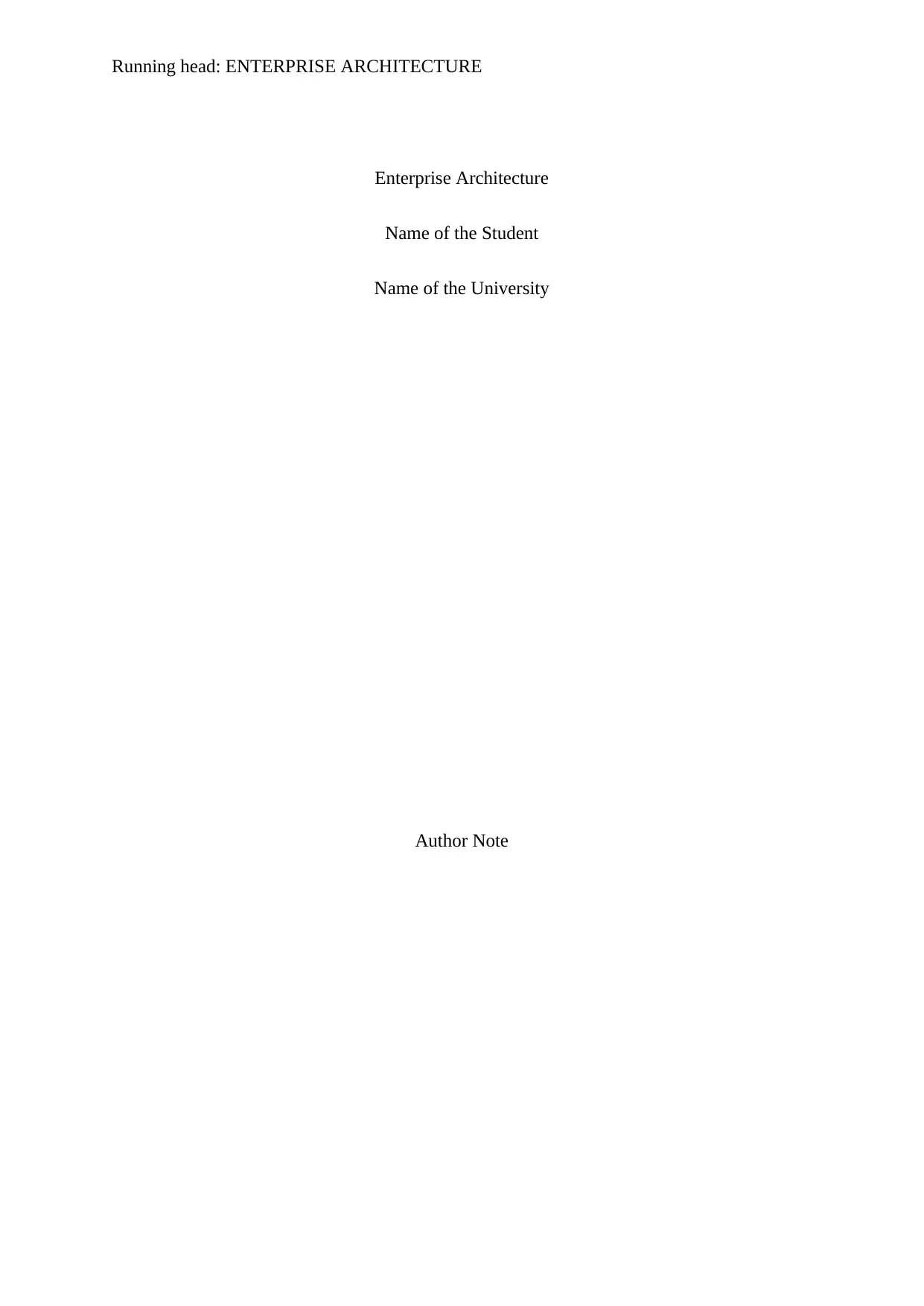
Running head: ENTERPRISE ARCHITECTURE
Enterprise Architecture
Name of the Student
Name of the University
Author Note
Enterprise Architecture
Name of the Student
Name of the University
Author Note
Paraphrase This Document
Need a fresh take? Get an instant paraphrase of this document with our AI Paraphraser
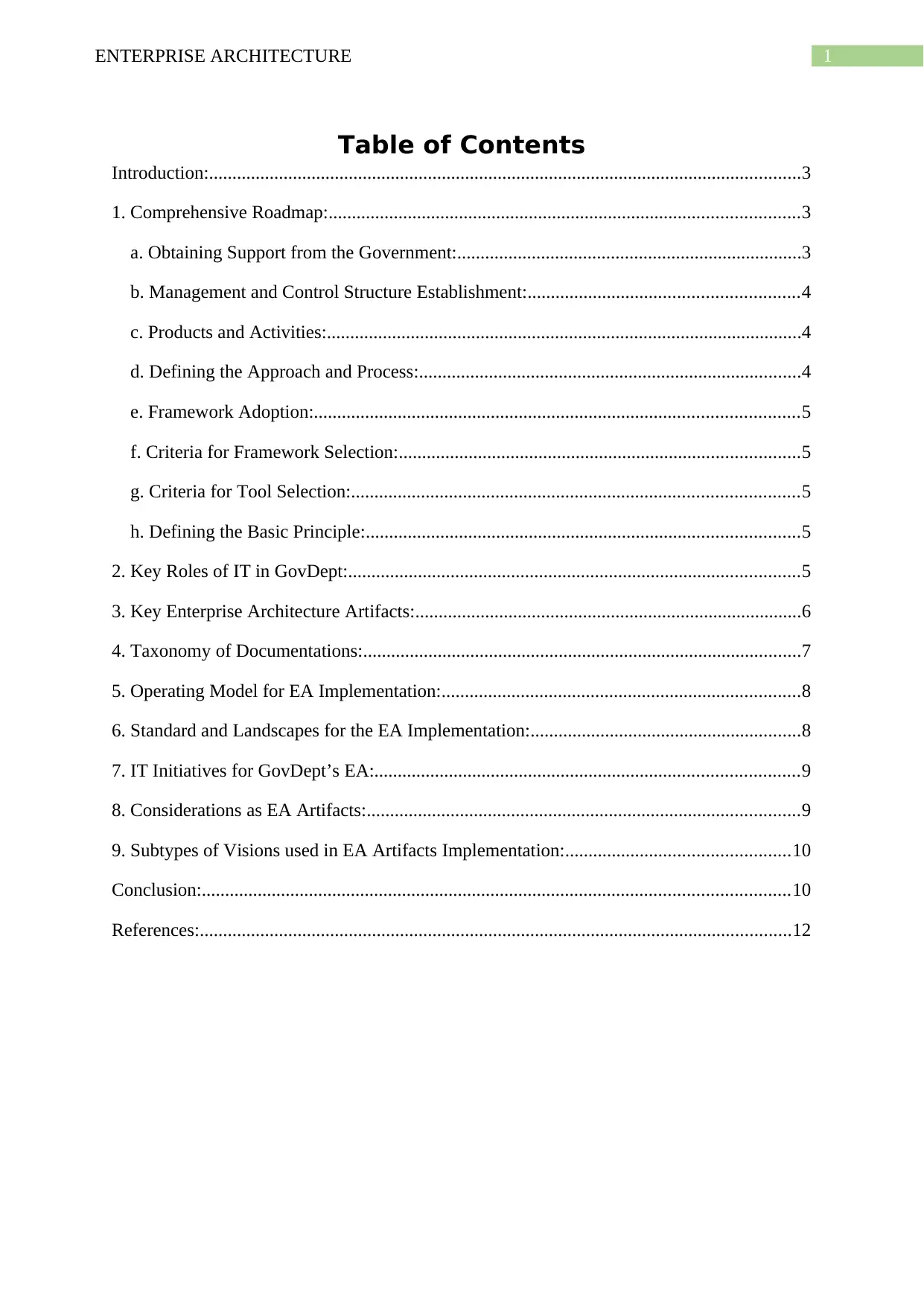
1ENTERPRISE ARCHITECTURE
Table of Contents
Introduction:...............................................................................................................................3
1. Comprehensive Roadmap:.....................................................................................................3
a. Obtaining Support from the Government:..........................................................................3
b. Management and Control Structure Establishment:..........................................................4
c. Products and Activities:......................................................................................................4
d. Defining the Approach and Process:..................................................................................4
e. Framework Adoption:........................................................................................................5
f. Criteria for Framework Selection:......................................................................................5
g. Criteria for Tool Selection:................................................................................................5
h. Defining the Basic Principle:.............................................................................................5
2. Key Roles of IT in GovDept:.................................................................................................5
3. Key Enterprise Architecture Artifacts:...................................................................................6
4. Taxonomy of Documentations:..............................................................................................7
5. Operating Model for EA Implementation:.............................................................................8
6. Standard and Landscapes for the EA Implementation:..........................................................8
7. IT Initiatives for GovDept’s EA:...........................................................................................9
8. Considerations as EA Artifacts:.............................................................................................9
9. Subtypes of Visions used in EA Artifacts Implementation:................................................10
Conclusion:..............................................................................................................................10
References:...............................................................................................................................12
Table of Contents
Introduction:...............................................................................................................................3
1. Comprehensive Roadmap:.....................................................................................................3
a. Obtaining Support from the Government:..........................................................................3
b. Management and Control Structure Establishment:..........................................................4
c. Products and Activities:......................................................................................................4
d. Defining the Approach and Process:..................................................................................4
e. Framework Adoption:........................................................................................................5
f. Criteria for Framework Selection:......................................................................................5
g. Criteria for Tool Selection:................................................................................................5
h. Defining the Basic Principle:.............................................................................................5
2. Key Roles of IT in GovDept:.................................................................................................5
3. Key Enterprise Architecture Artifacts:...................................................................................6
4. Taxonomy of Documentations:..............................................................................................7
5. Operating Model for EA Implementation:.............................................................................8
6. Standard and Landscapes for the EA Implementation:..........................................................8
7. IT Initiatives for GovDept’s EA:...........................................................................................9
8. Considerations as EA Artifacts:.............................................................................................9
9. Subtypes of Visions used in EA Artifacts Implementation:................................................10
Conclusion:..............................................................................................................................10
References:...............................................................................................................................12

2ENTERPRISE ARCHITECTURE
Introduction:
In the current aspect, GovDept is a medium sized government department which are
providing some important services to the population of a large territory. The current IT
system used by the GovDept is very old and due to this they are facing various issues in the
organizational operations. As the current IT infrastructure is creating problems for the
GovDept it is very much crucial to upgrade or replace the current system. Regarding this,
GovDept have already tried once to uplift the maturity of the Enterprise Architecture practice
and also tried to extend the scope of architectural planning but they were unsuccessful during
that time. Now, this time GovDept has again initiated a project for uplifting the enterprise
architecture practice of the organization with the help of external consultants. Regarding this,
in this report several of important aspects of the EA or the enterprise architecture will be
discussed which will help the GovDept to uplift the current practice of EA.
1. Comprehensive Roadmap:
For the GovDept the enterprise architecture or the EA can be an important business
asset and for that it is important to establish a proper plan so that EA practices can be evolved
within GovDept. Achieving EA practice within the organization will not be an easy task
considering high amount of effort is required for implementing the EA (Nikpay et al. 2017).
Thus, a proper roadmap is required for the establishment of EA practices within the GovDept.
In the following section the comprehensive roadmap for implementing the EA practices is
discussed.
a. Obtaining Support from the Government:
Implementation of EA practices are not easy and various of costs are associated with
it. As the GovDept is a governmental department, the first project of the GovDept will
Introduction:
In the current aspect, GovDept is a medium sized government department which are
providing some important services to the population of a large territory. The current IT
system used by the GovDept is very old and due to this they are facing various issues in the
organizational operations. As the current IT infrastructure is creating problems for the
GovDept it is very much crucial to upgrade or replace the current system. Regarding this,
GovDept have already tried once to uplift the maturity of the Enterprise Architecture practice
and also tried to extend the scope of architectural planning but they were unsuccessful during
that time. Now, this time GovDept has again initiated a project for uplifting the enterprise
architecture practice of the organization with the help of external consultants. Regarding this,
in this report several of important aspects of the EA or the enterprise architecture will be
discussed which will help the GovDept to uplift the current practice of EA.
1. Comprehensive Roadmap:
For the GovDept the enterprise architecture or the EA can be an important business
asset and for that it is important to establish a proper plan so that EA practices can be evolved
within GovDept. Achieving EA practice within the organization will not be an easy task
considering high amount of effort is required for implementing the EA (Nikpay et al. 2017).
Thus, a proper roadmap is required for the establishment of EA practices within the GovDept.
In the following section the comprehensive roadmap for implementing the EA practices is
discussed.
a. Obtaining Support from the Government:
Implementation of EA practices are not easy and various of costs are associated with
it. As the GovDept is a governmental department, the first project of the GovDept will
⊘ This is a preview!⊘
Do you want full access?
Subscribe today to unlock all pages.

Trusted by 1+ million students worldwide
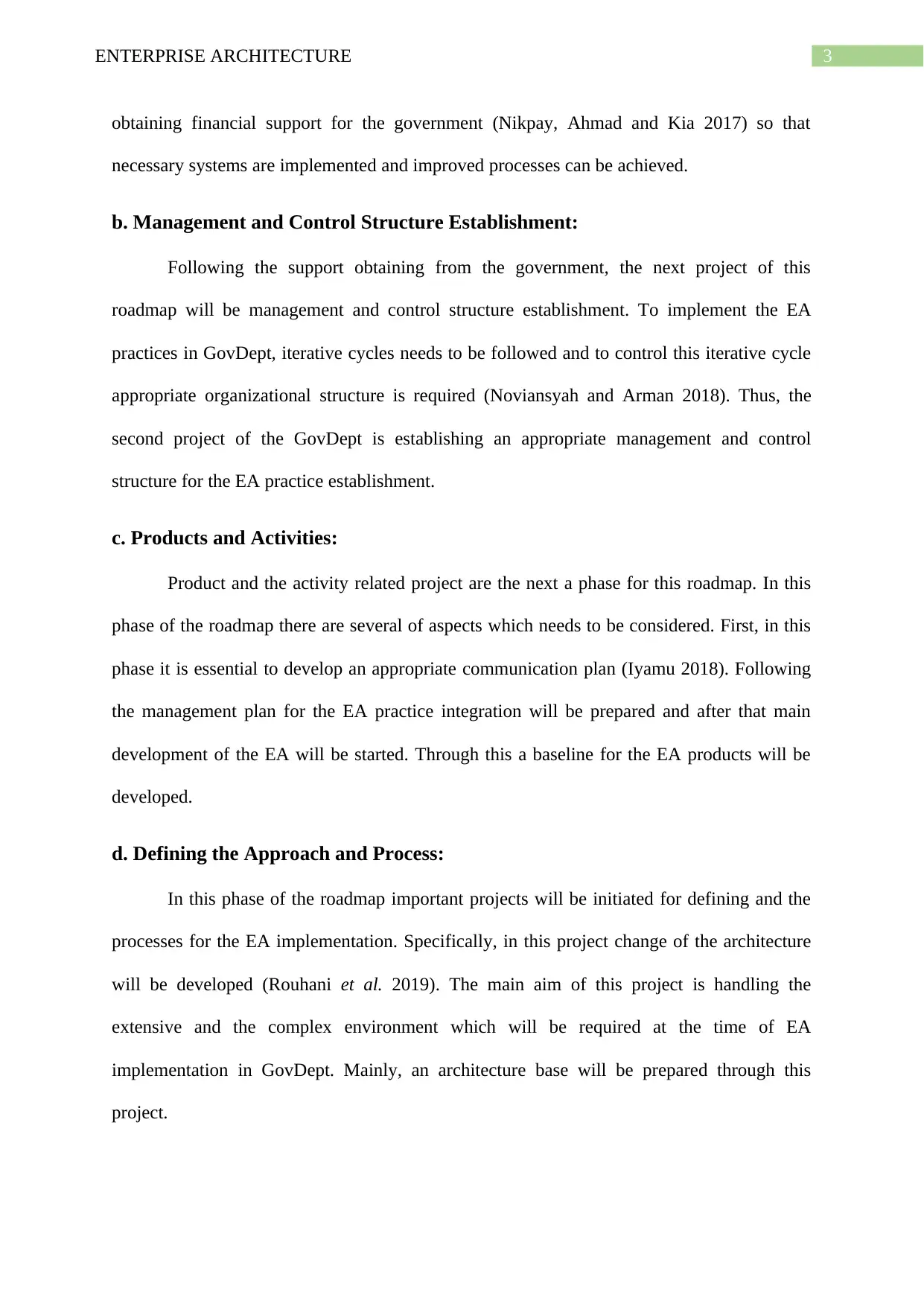
3ENTERPRISE ARCHITECTURE
obtaining financial support for the government (Nikpay, Ahmad and Kia 2017) so that
necessary systems are implemented and improved processes can be achieved.
b. Management and Control Structure Establishment:
Following the support obtaining from the government, the next project of this
roadmap will be management and control structure establishment. To implement the EA
practices in GovDept, iterative cycles needs to be followed and to control this iterative cycle
appropriate organizational structure is required (Noviansyah and Arman 2018). Thus, the
second project of the GovDept is establishing an appropriate management and control
structure for the EA practice establishment.
c. Products and Activities:
Product and the activity related project are the next a phase for this roadmap. In this
phase of the roadmap there are several of aspects which needs to be considered. First, in this
phase it is essential to develop an appropriate communication plan (Iyamu 2018). Following
the management plan for the EA practice integration will be prepared and after that main
development of the EA will be started. Through this a baseline for the EA products will be
developed.
d. Defining the Approach and Process:
In this phase of the roadmap important projects will be initiated for defining and the
processes for the EA implementation. Specifically, in this project change of the architecture
will be developed (Rouhani et al. 2019). The main aim of this project is handling the
extensive and the complex environment which will be required at the time of EA
implementation in GovDept. Mainly, an architecture base will be prepared through this
project.
obtaining financial support for the government (Nikpay, Ahmad and Kia 2017) so that
necessary systems are implemented and improved processes can be achieved.
b. Management and Control Structure Establishment:
Following the support obtaining from the government, the next project of this
roadmap will be management and control structure establishment. To implement the EA
practices in GovDept, iterative cycles needs to be followed and to control this iterative cycle
appropriate organizational structure is required (Noviansyah and Arman 2018). Thus, the
second project of the GovDept is establishing an appropriate management and control
structure for the EA practice establishment.
c. Products and Activities:
Product and the activity related project are the next a phase for this roadmap. In this
phase of the roadmap there are several of aspects which needs to be considered. First, in this
phase it is essential to develop an appropriate communication plan (Iyamu 2018). Following
the management plan for the EA practice integration will be prepared and after that main
development of the EA will be started. Through this a baseline for the EA products will be
developed.
d. Defining the Approach and Process:
In this phase of the roadmap important projects will be initiated for defining and the
processes for the EA implementation. Specifically, in this project change of the architecture
will be developed (Rouhani et al. 2019). The main aim of this project is handling the
extensive and the complex environment which will be required at the time of EA
implementation in GovDept. Mainly, an architecture base will be prepared through this
project.
Paraphrase This Document
Need a fresh take? Get an instant paraphrase of this document with our AI Paraphraser

4ENTERPRISE ARCHITECTURE
e. Framework Adoption:
The main project in this phase is adopting a framework for the EA adoption. There are
total five framework mainly adopted for the EA adoption. Depending on the requirement of
the GovDept an all the framework needs to be analysed in this case.
f. Criteria for Framework Selection:
In this phase a project will be initiated where important criteria will be identified.
Depending on these criteria appropriate framework will be selected for the EA practice
adoption project of GovDept.
g. Criteria for Tool Selection:
In this phase the main project will be selection of a tool that will be used for the EA
implementation purpose. The approach of tool selection is oriented by the selected
framework for the project.
h. Defining the Basic Principle:
This the last phase of the roadmap and in this phase basic principles of the roadmap
will be defined. The main aim of this project is development of an EA which will be
maintained periodically and will be evaluated continuously (Hristov 2017). It can be achieved
by defining the basic principle of the roadmap which will be done in this case.
2. Key Roles of IT in GovDept:
There are several of important aspects that GovDept will successfully achieve upon
successful implementation of IT. In the current aspect the initiated information technology by
the GovDept is the important EA practices. The important roles that the IT will play in the
GovDept are discussed below.
e. Framework Adoption:
The main project in this phase is adopting a framework for the EA adoption. There are
total five framework mainly adopted for the EA adoption. Depending on the requirement of
the GovDept an all the framework needs to be analysed in this case.
f. Criteria for Framework Selection:
In this phase a project will be initiated where important criteria will be identified.
Depending on these criteria appropriate framework will be selected for the EA practice
adoption project of GovDept.
g. Criteria for Tool Selection:
In this phase the main project will be selection of a tool that will be used for the EA
implementation purpose. The approach of tool selection is oriented by the selected
framework for the project.
h. Defining the Basic Principle:
This the last phase of the roadmap and in this phase basic principles of the roadmap
will be defined. The main aim of this project is development of an EA which will be
maintained periodically and will be evaluated continuously (Hristov 2017). It can be achieved
by defining the basic principle of the roadmap which will be done in this case.
2. Key Roles of IT in GovDept:
There are several of important aspects that GovDept will successfully achieve upon
successful implementation of IT. In the current aspect the initiated information technology by
the GovDept is the important EA practices. The important roles that the IT will play in the
GovDept are discussed below.
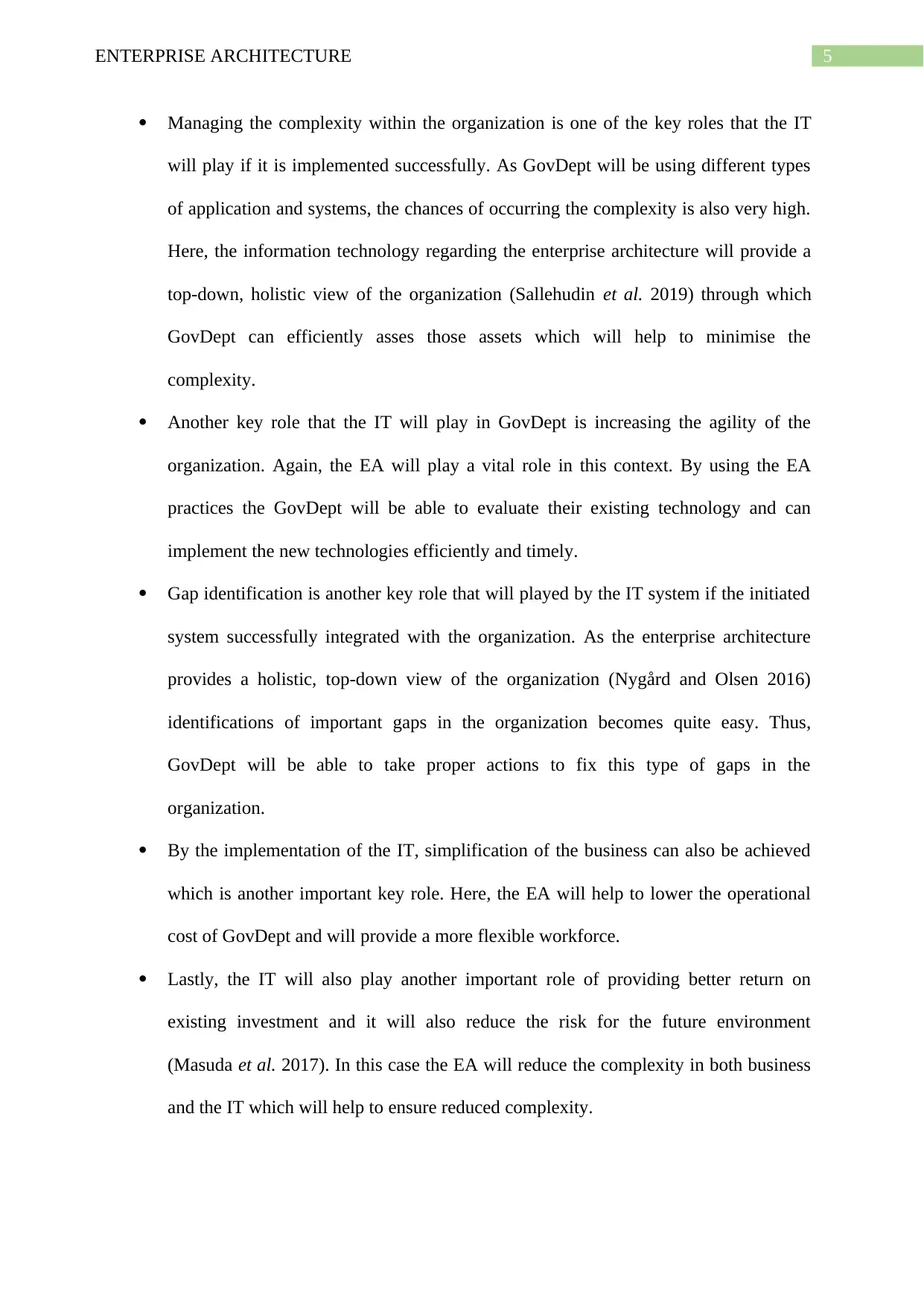
5ENTERPRISE ARCHITECTURE
Managing the complexity within the organization is one of the key roles that the IT
will play if it is implemented successfully. As GovDept will be using different types
of application and systems, the chances of occurring the complexity is also very high.
Here, the information technology regarding the enterprise architecture will provide a
top-down, holistic view of the organization (Sallehudin et al. 2019) through which
GovDept can efficiently asses those assets which will help to minimise the
complexity.
Another key role that the IT will play in GovDept is increasing the agility of the
organization. Again, the EA will play a vital role in this context. By using the EA
practices the GovDept will be able to evaluate their existing technology and can
implement the new technologies efficiently and timely.
Gap identification is another key role that will played by the IT system if the initiated
system successfully integrated with the organization. As the enterprise architecture
provides a holistic, top-down view of the organization (Nygård and Olsen 2016)
identifications of important gaps in the organization becomes quite easy. Thus,
GovDept will be able to take proper actions to fix this type of gaps in the
organization.
By the implementation of the IT, simplification of the business can also be achieved
which is another important key role. Here, the EA will help to lower the operational
cost of GovDept and will provide a more flexible workforce.
Lastly, the IT will also play another important role of providing better return on
existing investment and it will also reduce the risk for the future environment
(Masuda et al. 2017). In this case the EA will reduce the complexity in both business
and the IT which will help to ensure reduced complexity.
Managing the complexity within the organization is one of the key roles that the IT
will play if it is implemented successfully. As GovDept will be using different types
of application and systems, the chances of occurring the complexity is also very high.
Here, the information technology regarding the enterprise architecture will provide a
top-down, holistic view of the organization (Sallehudin et al. 2019) through which
GovDept can efficiently asses those assets which will help to minimise the
complexity.
Another key role that the IT will play in GovDept is increasing the agility of the
organization. Again, the EA will play a vital role in this context. By using the EA
practices the GovDept will be able to evaluate their existing technology and can
implement the new technologies efficiently and timely.
Gap identification is another key role that will played by the IT system if the initiated
system successfully integrated with the organization. As the enterprise architecture
provides a holistic, top-down view of the organization (Nygård and Olsen 2016)
identifications of important gaps in the organization becomes quite easy. Thus,
GovDept will be able to take proper actions to fix this type of gaps in the
organization.
By the implementation of the IT, simplification of the business can also be achieved
which is another important key role. Here, the EA will help to lower the operational
cost of GovDept and will provide a more flexible workforce.
Lastly, the IT will also play another important role of providing better return on
existing investment and it will also reduce the risk for the future environment
(Masuda et al. 2017). In this case the EA will reduce the complexity in both business
and the IT which will help to ensure reduced complexity.
⊘ This is a preview!⊘
Do you want full access?
Subscribe today to unlock all pages.

Trusted by 1+ million students worldwide
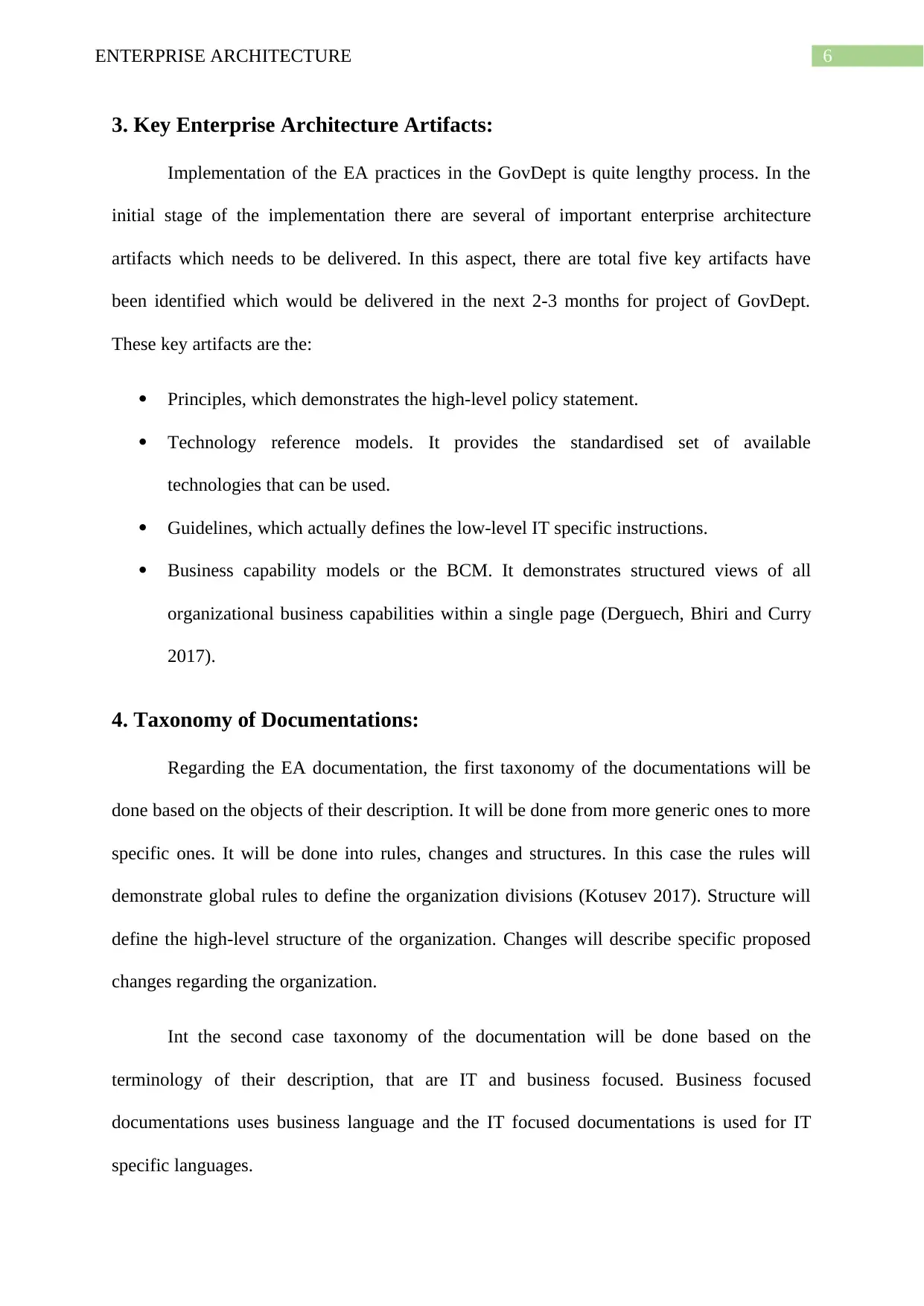
6ENTERPRISE ARCHITECTURE
3. Key Enterprise Architecture Artifacts:
Implementation of the EA practices in the GovDept is quite lengthy process. In the
initial stage of the implementation there are several of important enterprise architecture
artifacts which needs to be delivered. In this aspect, there are total five key artifacts have
been identified which would be delivered in the next 2-3 months for project of GovDept.
These key artifacts are the:
Principles, which demonstrates the high-level policy statement.
Technology reference models. It provides the standardised set of available
technologies that can be used.
Guidelines, which actually defines the low-level IT specific instructions.
Business capability models or the BCM. It demonstrates structured views of all
organizational business capabilities within a single page (Derguech, Bhiri and Curry
2017).
4. Taxonomy of Documentations:
Regarding the EA documentation, the first taxonomy of the documentations will be
done based on the objects of their description. It will be done from more generic ones to more
specific ones. It will be done into rules, changes and structures. In this case the rules will
demonstrate global rules to define the organization divisions (Kotusev 2017). Structure will
define the high-level structure of the organization. Changes will describe specific proposed
changes regarding the organization.
Int the second case taxonomy of the documentation will be done based on the
terminology of their description, that are IT and business focused. Business focused
documentations uses business language and the IT focused documentations is used for IT
specific languages.
3. Key Enterprise Architecture Artifacts:
Implementation of the EA practices in the GovDept is quite lengthy process. In the
initial stage of the implementation there are several of important enterprise architecture
artifacts which needs to be delivered. In this aspect, there are total five key artifacts have
been identified which would be delivered in the next 2-3 months for project of GovDept.
These key artifacts are the:
Principles, which demonstrates the high-level policy statement.
Technology reference models. It provides the standardised set of available
technologies that can be used.
Guidelines, which actually defines the low-level IT specific instructions.
Business capability models or the BCM. It demonstrates structured views of all
organizational business capabilities within a single page (Derguech, Bhiri and Curry
2017).
4. Taxonomy of Documentations:
Regarding the EA documentation, the first taxonomy of the documentations will be
done based on the objects of their description. It will be done from more generic ones to more
specific ones. It will be done into rules, changes and structures. In this case the rules will
demonstrate global rules to define the organization divisions (Kotusev 2017). Structure will
define the high-level structure of the organization. Changes will describe specific proposed
changes regarding the organization.
Int the second case taxonomy of the documentation will be done based on the
terminology of their description, that are IT and business focused. Business focused
documentations uses business language and the IT focused documentations is used for IT
specific languages.
Paraphrase This Document
Need a fresh take? Get an instant paraphrase of this document with our AI Paraphraser
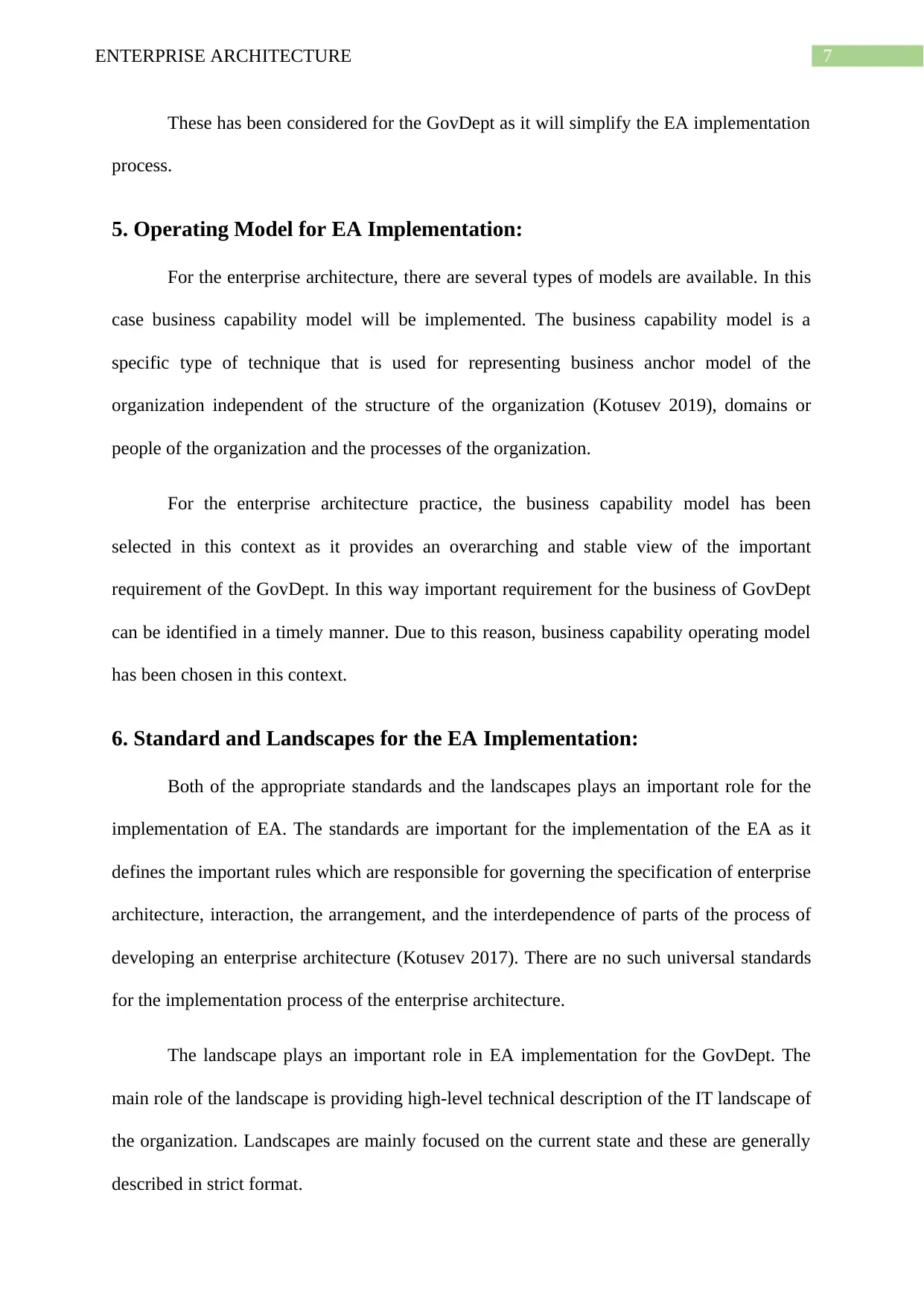
7ENTERPRISE ARCHITECTURE
These has been considered for the GovDept as it will simplify the EA implementation
process.
5. Operating Model for EA Implementation:
For the enterprise architecture, there are several types of models are available. In this
case business capability model will be implemented. The business capability model is a
specific type of technique that is used for representing business anchor model of the
organization independent of the structure of the organization (Kotusev 2019), domains or
people of the organization and the processes of the organization.
For the enterprise architecture practice, the business capability model has been
selected in this context as it provides an overarching and stable view of the important
requirement of the GovDept. In this way important requirement for the business of GovDept
can be identified in a timely manner. Due to this reason, business capability operating model
has been chosen in this context.
6. Standard and Landscapes for the EA Implementation:
Both of the appropriate standards and the landscapes plays an important role for the
implementation of EA. The standards are important for the implementation of the EA as it
defines the important rules which are responsible for governing the specification of enterprise
architecture, interaction, the arrangement, and the interdependence of parts of the process of
developing an enterprise architecture (Kotusev 2017). There are no such universal standards
for the implementation process of the enterprise architecture.
The landscape plays an important role in EA implementation for the GovDept. The
main role of the landscape is providing high-level technical description of the IT landscape of
the organization. Landscapes are mainly focused on the current state and these are generally
described in strict format.
These has been considered for the GovDept as it will simplify the EA implementation
process.
5. Operating Model for EA Implementation:
For the enterprise architecture, there are several types of models are available. In this
case business capability model will be implemented. The business capability model is a
specific type of technique that is used for representing business anchor model of the
organization independent of the structure of the organization (Kotusev 2019), domains or
people of the organization and the processes of the organization.
For the enterprise architecture practice, the business capability model has been
selected in this context as it provides an overarching and stable view of the important
requirement of the GovDept. In this way important requirement for the business of GovDept
can be identified in a timely manner. Due to this reason, business capability operating model
has been chosen in this context.
6. Standard and Landscapes for the EA Implementation:
Both of the appropriate standards and the landscapes plays an important role for the
implementation of EA. The standards are important for the implementation of the EA as it
defines the important rules which are responsible for governing the specification of enterprise
architecture, interaction, the arrangement, and the interdependence of parts of the process of
developing an enterprise architecture (Kotusev 2017). There are no such universal standards
for the implementation process of the enterprise architecture.
The landscape plays an important role in EA implementation for the GovDept. The
main role of the landscape is providing high-level technical description of the IT landscape of
the organization. Landscapes are mainly focused on the current state and these are generally
described in strict format.
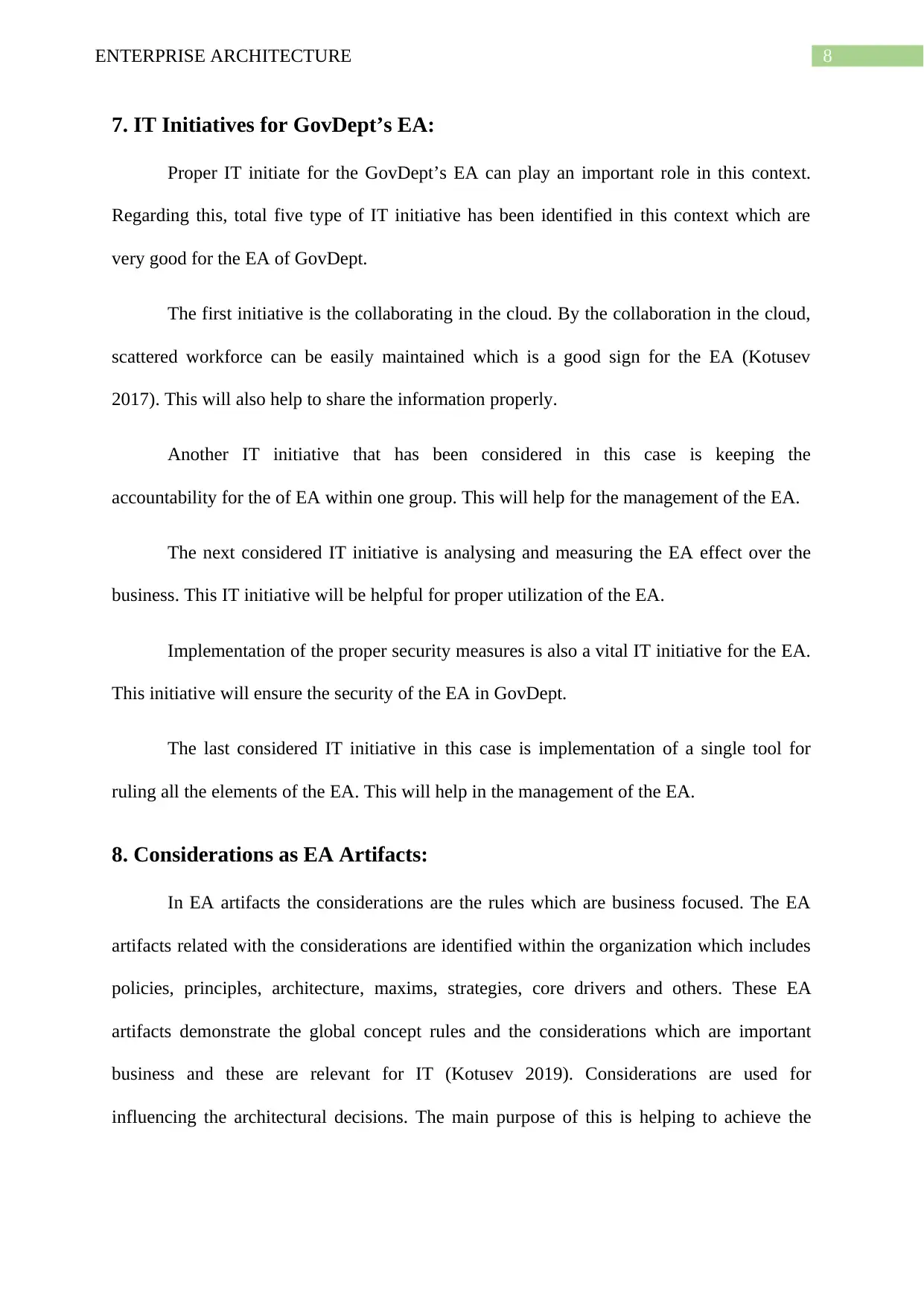
8ENTERPRISE ARCHITECTURE
7. IT Initiatives for GovDept’s EA:
Proper IT initiate for the GovDept’s EA can play an important role in this context.
Regarding this, total five type of IT initiative has been identified in this context which are
very good for the EA of GovDept.
The first initiative is the collaborating in the cloud. By the collaboration in the cloud,
scattered workforce can be easily maintained which is a good sign for the EA (Kotusev
2017). This will also help to share the information properly.
Another IT initiative that has been considered in this case is keeping the
accountability for the of EA within one group. This will help for the management of the EA.
The next considered IT initiative is analysing and measuring the EA effect over the
business. This IT initiative will be helpful for proper utilization of the EA.
Implementation of the proper security measures is also a vital IT initiative for the EA.
This initiative will ensure the security of the EA in GovDept.
The last considered IT initiative in this case is implementation of a single tool for
ruling all the elements of the EA. This will help in the management of the EA.
8. Considerations as EA Artifacts:
In EA artifacts the considerations are the rules which are business focused. The EA
artifacts related with the considerations are identified within the organization which includes
policies, principles, architecture, maxims, strategies, core drivers and others. These EA
artifacts demonstrate the global concept rules and the considerations which are important
business and these are relevant for IT (Kotusev 2019). Considerations are used for
influencing the architectural decisions. The main purpose of this is helping to achieve the
7. IT Initiatives for GovDept’s EA:
Proper IT initiate for the GovDept’s EA can play an important role in this context.
Regarding this, total five type of IT initiative has been identified in this context which are
very good for the EA of GovDept.
The first initiative is the collaborating in the cloud. By the collaboration in the cloud,
scattered workforce can be easily maintained which is a good sign for the EA (Kotusev
2017). This will also help to share the information properly.
Another IT initiative that has been considered in this case is keeping the
accountability for the of EA within one group. This will help for the management of the EA.
The next considered IT initiative is analysing and measuring the EA effect over the
business. This IT initiative will be helpful for proper utilization of the EA.
Implementation of the proper security measures is also a vital IT initiative for the EA.
This initiative will ensure the security of the EA in GovDept.
The last considered IT initiative in this case is implementation of a single tool for
ruling all the elements of the EA. This will help in the management of the EA.
8. Considerations as EA Artifacts:
In EA artifacts the considerations are the rules which are business focused. The EA
artifacts related with the considerations are identified within the organization which includes
policies, principles, architecture, maxims, strategies, core drivers and others. These EA
artifacts demonstrate the global concept rules and the considerations which are important
business and these are relevant for IT (Kotusev 2019). Considerations are used for
influencing the architectural decisions. The main purpose of this is helping to achieve the
⊘ This is a preview!⊘
Do you want full access?
Subscribe today to unlock all pages.

Trusted by 1+ million students worldwide
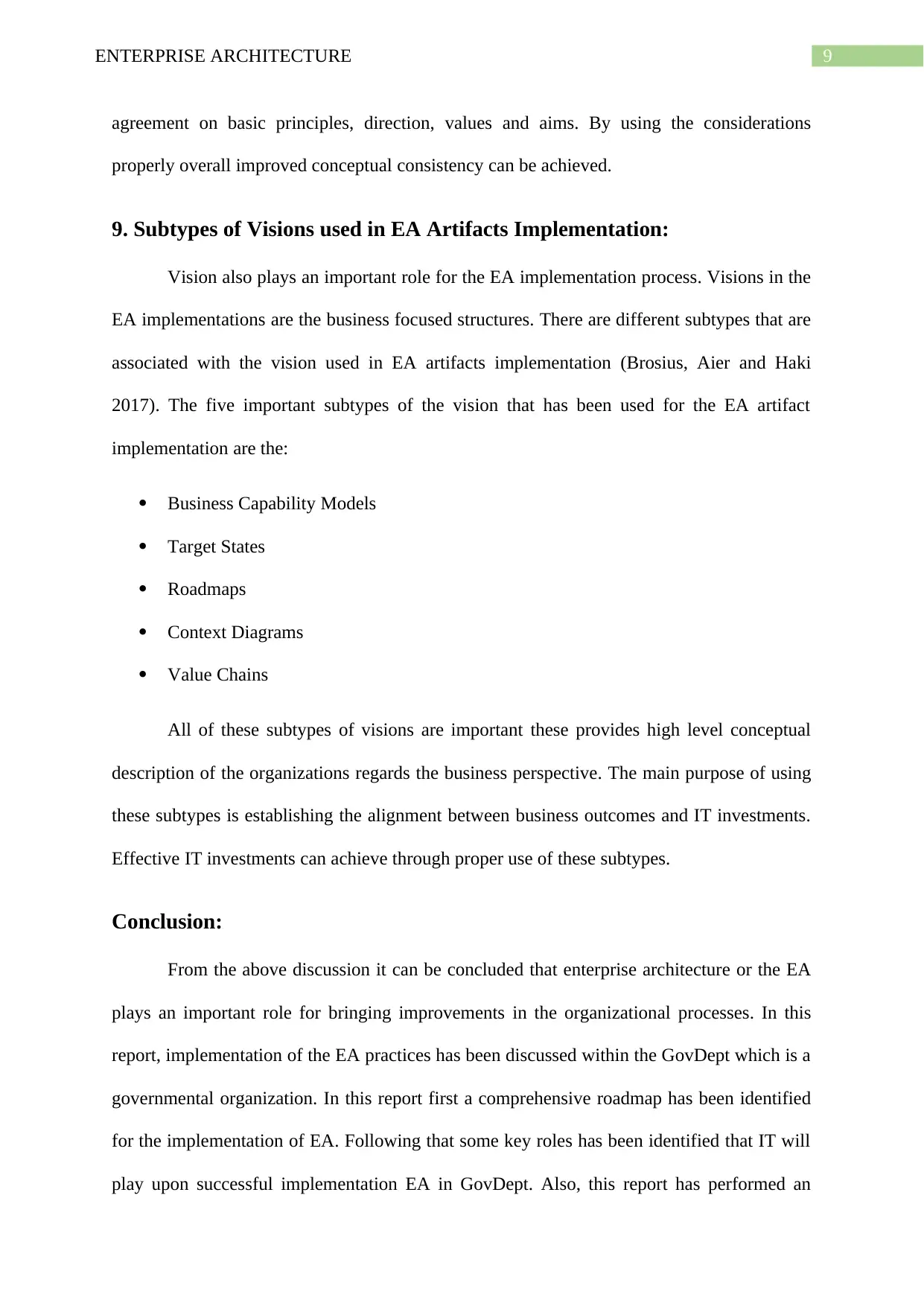
9ENTERPRISE ARCHITECTURE
agreement on basic principles, direction, values and aims. By using the considerations
properly overall improved conceptual consistency can be achieved.
9. Subtypes of Visions used in EA Artifacts Implementation:
Vision also plays an important role for the EA implementation process. Visions in the
EA implementations are the business focused structures. There are different subtypes that are
associated with the vision used in EA artifacts implementation (Brosius, Aier and Haki
2017). The five important subtypes of the vision that has been used for the EA artifact
implementation are the:
Business Capability Models
Target States
Roadmaps
Context Diagrams
Value Chains
All of these subtypes of visions are important these provides high level conceptual
description of the organizations regards the business perspective. The main purpose of using
these subtypes is establishing the alignment between business outcomes and IT investments.
Effective IT investments can achieve through proper use of these subtypes.
Conclusion:
From the above discussion it can be concluded that enterprise architecture or the EA
plays an important role for bringing improvements in the organizational processes. In this
report, implementation of the EA practices has been discussed within the GovDept which is a
governmental organization. In this report first a comprehensive roadmap has been identified
for the implementation of EA. Following that some key roles has been identified that IT will
play upon successful implementation EA in GovDept. Also, this report has performed an
agreement on basic principles, direction, values and aims. By using the considerations
properly overall improved conceptual consistency can be achieved.
9. Subtypes of Visions used in EA Artifacts Implementation:
Vision also plays an important role for the EA implementation process. Visions in the
EA implementations are the business focused structures. There are different subtypes that are
associated with the vision used in EA artifacts implementation (Brosius, Aier and Haki
2017). The five important subtypes of the vision that has been used for the EA artifact
implementation are the:
Business Capability Models
Target States
Roadmaps
Context Diagrams
Value Chains
All of these subtypes of visions are important these provides high level conceptual
description of the organizations regards the business perspective. The main purpose of using
these subtypes is establishing the alignment between business outcomes and IT investments.
Effective IT investments can achieve through proper use of these subtypes.
Conclusion:
From the above discussion it can be concluded that enterprise architecture or the EA
plays an important role for bringing improvements in the organizational processes. In this
report, implementation of the EA practices has been discussed within the GovDept which is a
governmental organization. In this report first a comprehensive roadmap has been identified
for the implementation of EA. Following that some key roles has been identified that IT will
play upon successful implementation EA in GovDept. Also, this report has performed an
Paraphrase This Document
Need a fresh take? Get an instant paraphrase of this document with our AI Paraphraser
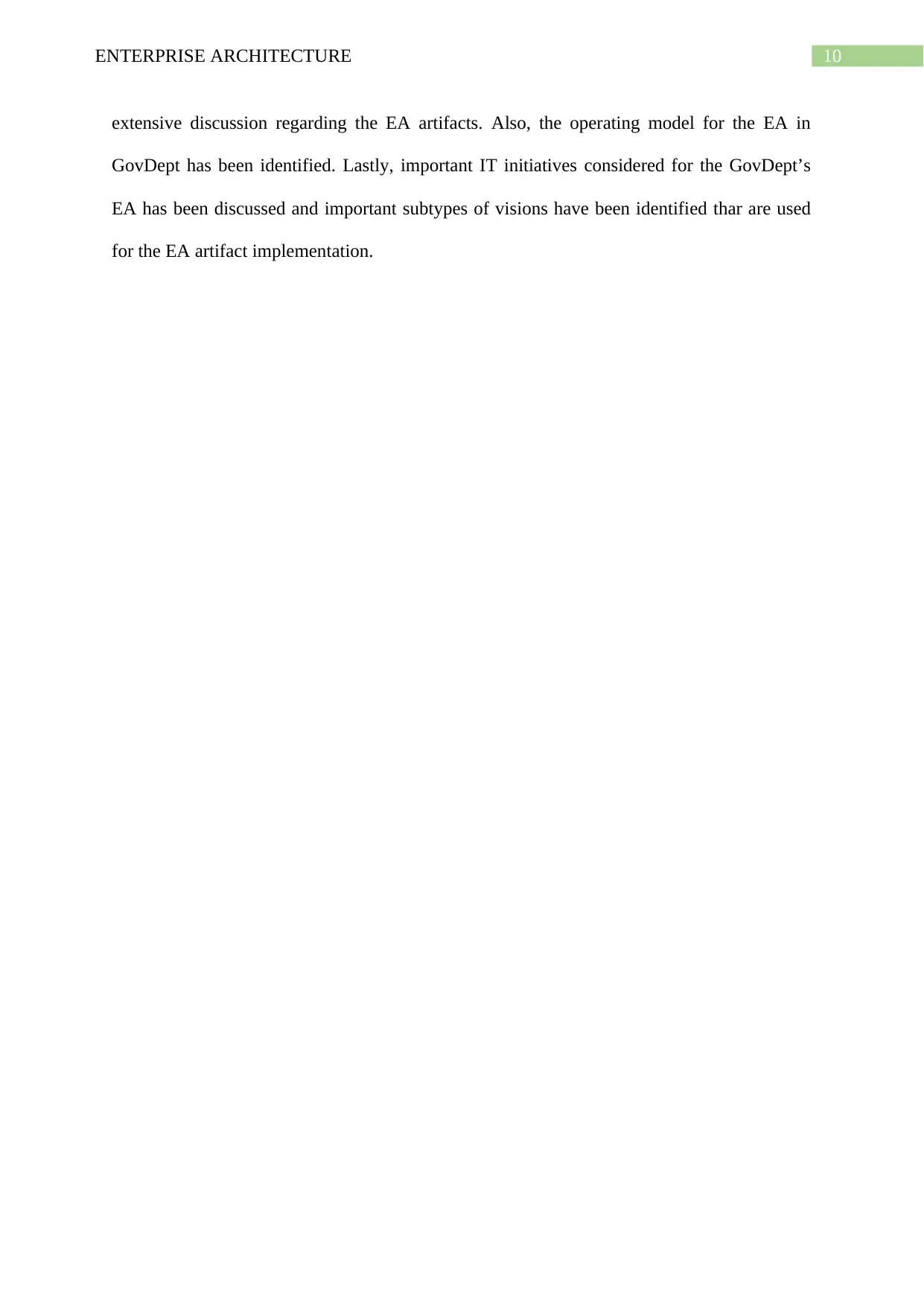
10ENTERPRISE ARCHITECTURE
extensive discussion regarding the EA artifacts. Also, the operating model for the EA in
GovDept has been identified. Lastly, important IT initiatives considered for the GovDept’s
EA has been discussed and important subtypes of visions have been identified thar are used
for the EA artifact implementation.
extensive discussion regarding the EA artifacts. Also, the operating model for the EA in
GovDept has been identified. Lastly, important IT initiatives considered for the GovDept’s
EA has been discussed and important subtypes of visions have been identified thar are used
for the EA artifact implementation.

11ENTERPRISE ARCHITECTURE
References:
Brosius, M., Aier, S. and Haki, M.K., 2017, October. Introducing a coordination perspective
to enterprise architecture management research. In 2017 IEEE 21st International Enterprise
Distributed Object Computing Workshop (EDOCW) (pp. 71-78). IEEE.
Derguech, W., Bhiri, S. and Curry, E., 2017. Designing business capability-aware
configurable process models. Information Systems, 72, pp.77-94.
Hristov, N., 2017, July. Policy for Implementation of the Enterprise Architecture as a Tool in
Bulgarian Mod. In The University of Sydney,‘History, Problems and Prospects of
Development of Modern Civilization’The XX International Academic Congress (Australia,
Sydney, 18-20 July 2017) PAPERS AND COMMENTARIES (Vol. 20).
Iyamu, T., 2018. Implementation of the enterprise architecture through the Zachman
Framework. Journal of Systems and Information Technology.
Kotusev, S., 2017. Eight Essential Enterprise Architecture Artifacts. British Computer
Society (BCS), URL: http://www. bcs. org/content/conWebDoc/57318.
Kotusev, S., 2017. Enterprise Architecture on a Single Page. British Computer Society (BCS),
URL: http://www. bcs. org/content/conWebDoc/58615.
Kotusev, S., 2017. The Relationship Between Enterprise Architecture Artifacts. British
Computer Society (BCS), URL: http://www. bcs. org/content/conWebDoc/57563.
Kotusev, S., 2019. Enterprise architecture and enterprise architecture artifacts: Questioning
the old concept in light of new findings. Journal of Information technology, 34(2), pp.102-
128.
References:
Brosius, M., Aier, S. and Haki, M.K., 2017, October. Introducing a coordination perspective
to enterprise architecture management research. In 2017 IEEE 21st International Enterprise
Distributed Object Computing Workshop (EDOCW) (pp. 71-78). IEEE.
Derguech, W., Bhiri, S. and Curry, E., 2017. Designing business capability-aware
configurable process models. Information Systems, 72, pp.77-94.
Hristov, N., 2017, July. Policy for Implementation of the Enterprise Architecture as a Tool in
Bulgarian Mod. In The University of Sydney,‘History, Problems and Prospects of
Development of Modern Civilization’The XX International Academic Congress (Australia,
Sydney, 18-20 July 2017) PAPERS AND COMMENTARIES (Vol. 20).
Iyamu, T., 2018. Implementation of the enterprise architecture through the Zachman
Framework. Journal of Systems and Information Technology.
Kotusev, S., 2017. Eight Essential Enterprise Architecture Artifacts. British Computer
Society (BCS), URL: http://www. bcs. org/content/conWebDoc/57318.
Kotusev, S., 2017. Enterprise Architecture on a Single Page. British Computer Society (BCS),
URL: http://www. bcs. org/content/conWebDoc/58615.
Kotusev, S., 2017. The Relationship Between Enterprise Architecture Artifacts. British
Computer Society (BCS), URL: http://www. bcs. org/content/conWebDoc/57563.
Kotusev, S., 2019. Enterprise architecture and enterprise architecture artifacts: Questioning
the old concept in light of new findings. Journal of Information technology, 34(2), pp.102-
128.
⊘ This is a preview!⊘
Do you want full access?
Subscribe today to unlock all pages.

Trusted by 1+ million students worldwide
1 out of 14